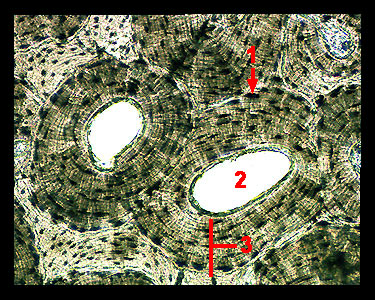|
|
||||||||||||||||||||||||||||||||||||||||||||||||||||||||||||||||||||||||||||||||||||||||||||||||||||||||||||||||
|
This image shows a dried section of compact bone. Like cartilage, bone cells (osteocytes) occupy spaces (lacunae) found within the dense matrix. A major difference, however, is that the matrix is calcified in bone, which endows bone with the property of hardness and the ability to resist compressive forces. This calcified matrix is deposited in layers called lamellae (singular = lamella) approximately 3-7 microns thick. The most common unit of structure in compact bone is the Haversian system or osteon. In each Haversian system, the lamellae are arranged concentrically around a central Haversian canal which houses nerves and blood vessels (unlike cartilage, bone is well supplied with blood vessels). The lacunae that house mature osteocytes in living bone appear as tapered, black spaces arranged around the concentric lamellae. Slender, branching tubules called canaliculi ("little canals") radiate out from the lacunae to form an extensive network of passageways that connect the bone cells to each other and to the blood supply in the Haversian canal. |
|
